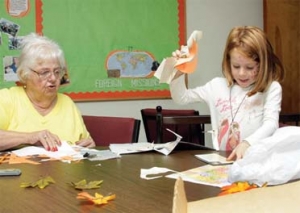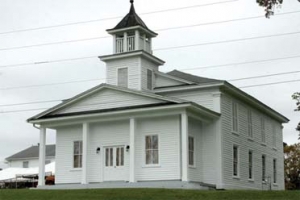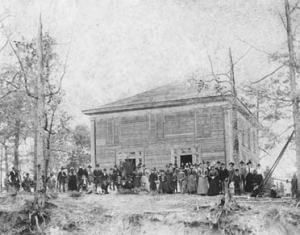Many have 'First' in their names, but Bear Marsh is the original
By Josh Ellerbrock
Published in News on October 20, 2013 1:50 AM

News-Argus/BOBBY WILLIAMS
Ann Byrd, one of the longest running members of Bear Marsh Baptist Church, works on the church bulletin board with her granddaughter, Ava, Friday.
MOUNT OLIVE -- There are First Baptist churches, and then there is "The First" Baptist church -- the progenitor, the predecessor, the true "mother church" of the rest of Baptist churches, older than the United States itself -- Bear Marsh Baptist Church located down in Duplin County.
A simple cube-shaped building settled up on a small hill with a manicured lawn, Bear Marsh Baptist Church has seen thousands of church members come and go in its 250 years of history.
According to documents written by church historian Austin House, church members originally from Bear Marsh Baptist Church helped create Pleasant Plains Baptist Church near Seven Springs, Prospect Baptist Church near Albertson (neither still exist), Johnson Baptist Church, Kenansville Baptist Church, Mount Olive First Baptist Church, Concord Baptist Church, Faison Baptist Church, Falling Creek Baptist Church and a Baptist church in Waynesborough which later became the Goldsboro First Baptist Church.
The church is
celebrating its 250th birthday with a
celebration today.
The worship service will start at 10 a.m., a luncheon will be immediately following and a song service will start at 2 p.m.
•
The church (and the rest of the subsequent Baptist churches in the area) started when five men and five women requested the help in the establishment of a
Baptist Church. At that request, some "brethren" from Pitt County sent Elders John Nobles and Jeremiah Rhame down to Duplin. With their help, the first iteration of the church, a simple log meeting house, was built 100 yards from the building's current location. A graveyard now marks the spot.
By 1790, the first building burnt down and parishioners built a new meeting house (this one was made of longleaf pine times and chap board siding) at the location the church currently stands. Church members moved the site to have better access to a newly built dirt road.
In 1833, the second meeting house burned down, and the third meeting house was built. Some argue that another fire burned down that meeting house 20 years later.
Bear Marsh historian, Austin House, disagrees with that assertion. House said that by the 1850s the church's membership, more than 350 people, required an expansion of the church to fit the growth.
And that frame still stands as the current church building. But there have been some major renovations.
That first major renovation happened in 1900 with the removal of the slave balcony and its support structure made out of heavy timber.
At that time, the ceiling of the church was lowered; the upper section of the church was closed off, and the top windows were boarded up.
•
In 1926, John "B." Faulk entered the history of Bear Marsh Baptist Church.
Finding someone with firsthand knowledge of 250 years of church history is sadly impossible, but if 87-year-old John (known as "B") Faulk had lived that long, he would have gladly recounted it with his wandering storytelling style.
Sitting in a leather recliner, listening to soft gospels on the radio with a WWII magazine sitting on his lap, Faulk started his story with what he knew of his parents, who moved down to Duplin County back in 1900 (Faulk wasn't alive at the time).
Faulk's story began with his mother complaining about the removal of the slave
balcony -- a point of contention in the church between the historical-minded members and the progressives.
Faulk said the church lost something when they took out the balcony, and it wasn't just the historical importance. Back then, tolling the bells never shook the church, and now there's a rattle to the structure, he claims.
Faulk's official first memories of the church begin in Sunday school in "card class." At five years old and without the ability to read, children entertained themselves with illustrated cards given to them by Sunday school teachers.
When he aged out of Sunday school, he started joining the Sunday sermons, which, Faulk said, were a lot different and a lot longer than those today.
When people gathered on Sundays, automobiles were complemented by a few two-horse wagons parked in the yard beside the church's oak tree-filled yard. But not all families back then had transportation.
Some families walked the three miles or less to church while dressed in their Sunday finery.
"People were really dedicated to church when I was a boy," Faulk said.
When families got there after an hour of walking, they usually separated. Women and children sat on the left, and men sat on the right.
"Neither one would be caught on either side. You just didn't go," Faulk said.
Faulk said it's still that way, but the younger men don't realize they're sitting on the women's side.
Early in Faulk's and his wife Alice's relationship, Faulk caused a scandal when he brought Mrs. Faulk to Bear Marsh and led her to the right side to sit with him.
"I reckon we did because you wouldn't sit with the women," she said.
Mrs. Faulk is used to causing scandal. Out of all the women at Bear Marsh, only she refused to wear one of those big floppy hats that were in vogue in the 1960s.
"I was the rebel down there. I didn't wear a hat," she said.
The church was further divided by gender due to the drugs of choice. Although both sides had tobacco spittoons as "big as wash basins," men were the ones spitting (sometimes from 10 feet away), and the women used snuff boxes.
When the church decided to take a break, men would go out front by the old oak tree and have a smoke. During that time, the men would sing hymns -- just a few -- before church and the preacher got riled back up.
"Back then the preachers put the spirit on them," Faulk said. "It was plain and simple. There was some preaching going on back then."
He explained how preachers would wander back and forth on the pulpit admonishing and exhorting while sharply stomping a few feet over the Baptism tank for hours at a time.
"I was afraid of him stomping all day. He had a 1000 gallon tank underneath him," Mrs. Faulk said.
The men would let out affirmations -- "Yes, brother! Amen!" -- and the women, well, they were more seen and not heard back in those days, Faulk said.
The church changed too. Eventually, the church got rid of the tobacco spittoons during another renovation. The front of the church was also redone to have one primary door instead of two smaller ones.
The trees out front were removed, and central air replaced the two heaters in the middle of the aisles.
Since Faulk's day, church membership also changed. From the 1930s to 1970s, the church averaged 250 members, and today, it's down to 130 members.
•
Yet come this morning, both John and Alice Faulk were hoping that the church's sestercentennial will be as well-attended as the church's bicentennial held back in 1963.
At that time, tables and tables of food were laid out on the church's lawn. Cars overflowed the field-converted-parking-lot. Attendance for the grand event was estimated at about 1,000, and even the "president of the Baptist Association, Herschel Hobbs, flew down to
congratulate the church on 200 years of success.
"People were there who hadn't been there for years," he said.
If taking the "mother church" status into account, it shouldn't be too hard to bring in more than 1,000 members. The event should draw all the Baptists in Wayne and Duplin
counties.
"It's been a grand ole' church. It's a great place to go," Faulk said. "It's a well known place. There are some mighty good folks there."


